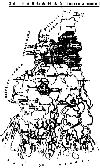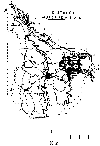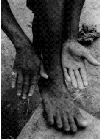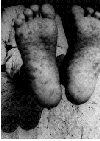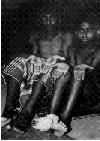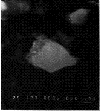|
(c) 1997 Chapman & Hall. Reprinted with permission. | TABLE OF CONTENTS | ARSENIC CRISIS INFO CENTRE HOME | Environmental Geochemistry and Health (1996), 18, 5-15 (0269-4042 # 1996 Chapman & Hall) Arsenic in ground water in six districts of West Bengal, IndiaDipankar Das, Gautam Samanta, Badal Kumar Mandal, Tarit Roy Chowdhury, Chitta Ranjan Chanda, Partha Pratim Chowdhury, Gautam Kumar Basu and Dipankar Chakraborti * School of Environmental Studies, Jadavpur University, Calcutta - 700032, India
Abstract Arsenic in groundwater above the WHO maximum permissible limit of 0.05 mg l -1 has been found in six districts of West Bengal covering an area of 34 000 km2 with a population of 30 million. At present, 37 administrative blocks by the side of the River Ganga and adjoining areas are affected. Areas affected by arsenic contamination in ground-water are all located in the upper delta plain, and are mostly in the abandoned meander belt. More than 800 000 people from 312 villages/wards are drinking arsenic contaminated water and amongst them at least 175 000 people show arsenical skin lesions. Thousands of tube-well water in these six districts have been analysed for arsenic species. Hair, nails, scales, urine, liver tissue analyses show elevated concentrations of arsenic in people drinking arsenic-contaminated water for a longer period. The source of the arsenic is geological. Bore-hole sediment analyses show high arsenic concentrations in only few soil layers which is found to be associated with iron-pyrites. Various social problems arise due to arsenical skin lesions in these districts. Malnutrition, poor socio-economic conditions, illiteracy, food habits and intake of arsenic-contaminated water for many years have aggravated the arsenic toxicity. In all these districts, major water demands are met from groundwater and the geochemical reaction, caused by high withdrawal of water may be the cause of arsenic leaching from the source. If alternative water resources are not utilised, a good percentage of the 30 million people of these six districts may suffer from arsenic toxicity in the near future. Keywords: Arsenic, arsenic poisoning, groundwater, West Bengal. * To whom correspondence should be addressed. Table of Contents
IntroductionIntermittent incidents of arsenic contamination in groundwater and the consequent ill health of people from arsenic poisoning have been widely reported. There are many clinical manifestations but the most commonly observed symptoms of chronic arsenic poisoning are conjunctivitis, melanosis and hyperkeratosis. In severe cases, gangrene in the limbs and malignant neoplasm have also been observed. The arsenic contamination incident in the well-water of Taiwan (1961-85) is well known (Lu, 1990). The population of the endemic area was about 100,000. Both arsenism and black-foot disease were limited to people drinking artesian well-water with a variable but high concentration of arsenic (0.10 - 1.8 mg l-1 ). The report (Borgono & Greiber, 1971) of a similar problem in Antofagasta, Chile, shows that almost 100 000 inhabitants of that city out of a total population of 130 000 were drinking water with a high arsenic content (0.8 mg l-1 ) for 12 years between 1959 and 1970. More than 12% of the population drinking water containing high arsenic exhibited dermatological manifestations related to arsenic. Chronic arsenic poisoning was also reported (Cebrian et al., 1983) in some parts of Region Lagunera, situated in the central part of North Mexico during 1963-83. The arsenic concentration in ground-water exposed to the population was 0.41 mg l-1 . Around 200 000 people in the region were reported to be exposed via drinking water to concentrations higher than 0.05 mg l-1 , and 21.61% of the exposed population showed at least one of the cutaneous signs of chronic arsenic poisoning. In Monte Quemado of Cordoba Province in the north of Argentina, a similar incident known as " the illness of Bell Ville (Cordoba)" was reported (Astolfi et al., 1981). The occurrence of endemic arsenical skin disease and cancer was first recognised in 1955. The total population of the endemic area was about 10 000. From the observations in the Cordoba it was concluded (Astolfi et al., 1981) that the regular intake of drinking water containing more than 0.1 mg l-1 of arsenic leads to clearly recognisable signs of arsenic toxicity and ultimately in some cases to skin cancer. Researchers followed 166 patients with clear signs of chronic arsenic disease over a number of years (Astolfi et al., 1981). After 15 years of follow up, 78 had died, 24 from cancer (i.e. 30.5% of total deaths). Thus, the literature shows that the major incidents of arsenic related diseases caused by drinking arsenic contaminated water were in Taiwan (Lu, 1990), Antofagasta (Borgono and Grebier, 1971), Mexico (Cebrian et al., 1983) and Argentina (Astolfi et al., 1981). Other minor incidents of arsenic poisoning from groundwater, where a small population group was affected (showing arsenical cutaneous manifestations) have been reported from Minnesota, USA (Feinglass, 1973), Ontario, Canada (Wyllie, 1937), Nova Scotia, Canada (Grantham and Jones, 1977), New Zealand (Ritchie, 1961), Nakajo, Japan (Terade et al., 1960). A borderline case was observed in Millard County, Utah (Southwick et al., 1983) where 250 people drinking well-water with arsenic content between 0.18 and 0.21 mg l-1, showed a slightly higher percent of abnormalities related to arsenic toxicity, although the arsenic in hair and urine were somewhat higher in the exposed population. By contrast, studies in Lane County, Oregon (Morton et al., 1976), Lassen County, California, USA (Goldsmith et al.,1972) and Fairbanks, Alaska (Harrington et al.,1978) reported that, although arsenic concentrations in groundwater were higher than the maximum permissible limit (0.05 mg l-1) and arsenic in urine, hair and nails of the people drinking arsenic contaminated water were high, no clinical or haematological abnormalities were observed in the exposed population. The problem of arsenic contamination in ground-water in six districts of West Bengal, India, that we will describe in this paper, is many times more severe than any incident previously reported. The total population drinking arsenic contaminated water, and the number of people showing arsenical clinical manifestations in these six districts, are much higher than those hitherto known from all other studies. We will describe the suffering of people drinking arsenic contaminated water, and also the arsenic concentrations in water and hair, nails, skin-scale, urine and liver tissues (biopsy sample) of affected people. We will also describe the probable source of arsenic, its mineralogy. MethodologyWater for analysis was taken from tubewells. Tubewells are bore-wells constructed mostly using hand augers. After completion of drilling, wells are cased, keeping a perforated screen against the aquifer. The pumping rate for each tube-well is approximately 2 L min-1 and is done manually. Skin was obtained by cutting small pieces of skin from palm and sole and is referred to as skin scales. Water, urine, hair, nails, sediments, skin scales and liver tissues were analysed using Xray fluorescence (XRF), electron probe micro analysis (EPMA), Zeeman graphite furnace AAS, FI-hydride-AAS, laser microprobe mass analyser (LAMMA) and X- ray powder-diffractometry. The XRF and EPMA instrumentations have been described previously (Chatterjee et al., 1993; Chakraborti et al.,1992). A LAMMA-500 (Leybold - Heraeus Cologne, Germany) was used to measure sediment samples, liver tissues and skin scales to get positive and negative mass spectra. A detailed description of LAMMA has been given elsewhere (Heinen et al.,1979). The sediment samples have also been studied using a Siemens D-5000 powder-diffractometer, with a Cu-target and excitation conditions of 45 kV, 39 mA, after the sediment samples have been separated into different fractions under the microscope and using a permanent magnet to distinguish morphological and magnetic properties. Arsenic in water, hair, nails, skin scale and urine samples was determined by FI-HG-AAS; instrumental parameters are described elsewhere (Das et al., 1995.) The liver tissues were analysed using Perkin Elmer Zeeman AAS with nickel as matrix modifier; the instrumentation was described previously (Chakraborti et al., 1993). A microwave oven, MDS-2000, CEM, New York was used to digest the samples. The mode of collection, sample treatment, analytical procedures for arsenic determination have been described previously (Chatterjee et al., 1993, Irgolic et al., 1983, Chakraborti et al., 1992). Bore-hole sediment analysisBore-hole sediment samples from Kamarpara, Malda and Barasat, North 24-Parganas were collected at every 3.3 m interval. In Kamarpara, samples could be collected down to a depth of 100 m (below which hard rock was encountered), while in Barasat, samples could be collected down to a depth of 370 m. The nature of the sediments as revealed from analyses of different bore-hole samples in the area indicate that there is mainly clay of varying thickness at the top followed successively by fine sand, fine-to-medium sand, coarse sand and, occasionally, gravels and silt. There are several such cyclothems in the study area. The Malda samples which are rich in arsenic, are mainly clay, while in Barasat the sediment is sandy. Sediment samples were processed as described elsewhere (Chatterjee et al., 1993). Regional settingRegional geologyThe area constitutes the southern part of the Bengal Basin, a pericratonic basin in northeastern India. The basin, which comprises the Ganges-Brahmaputra delta in its southern part, has had a long evolutionary history since its formation is a result of the break up of the Gondwanaland along its rifted passive margin of the Indian Plate and its subsequent northerly movement in early Cretaceous (126 Myr ago). The initial collision of the Indian and Eurasian Plates began in the early Eocene (40-41 Myr ago) and resulted in the initial uplift of the Himalayas. As a result of this convergence, the Ganges delta and the proto-Brahmaputra delta sediments were juxtaposed and gradually merged. Relatively recent folding and uplift (Quaternary epoch) of the Brahmaputra sediments close to the intraplate boundary redirected the course of the Brahmaputra to its present configuration (Morgan et al., 1959; Lindsay et al.,1991). The Ganga-Brahmaputra delta complex, which thickens towards the south, has three broad stratigraphic sequence viz: (1) the proto-Ganges delta formed immediately after the break up of the Gondwanaland (126 Myr ago); (2) the transitional delta (49.5-10.5 Myr ago); and (3) the modern delta (10.5 Myr ago-present) with a successive sequence of sands, sandy mud, silt and mud which were deposited under a major eustatic sea level low at about 10.5 Myr ago. The modern delta has been formed primarily of alluvial sediments transported by the rivers, e.g. the Mayurakshi, the Ajoy, the Damodar etc. originating from the Chotanagpur Uplands in the west and subsequently by the rivers flowing from the Himalayan foredeep basin e.g. the Ganges, the Padma, the Bhagirathi, the Brahmaputra etc. flowing from the north when a gap, the Garo-Rajmahal gap, was created due to tectonic movements (Auden, 1949). Arsenic contaminated groundwater occurs in the modern deltaic sediments. GeomorphologyThe modern delta can be divided into two macroform processes regions: (1) the upper delta plain of meander belts of the Padma- Bhagirathi rivers in the north; and (2) the lower delta plain with several tidal creeks in the south. The upper delta plain is characterised by a series of meander scars of various wavelengths and amplitudes, abandoned channels, oxbow lakes, formed under varying hydrodynamic conditions in a fluvial regime. Abandoned meander scrolls are the most common form and could be related to flood-plain formation in the upper delta plain with a very gentle southerly slope. Other land form features are levees, backswamps in between interdistributary levees etc. The sediments of this plain consist of several fining upward sequences (clay-silt- sand). Such cyclothems in the form of festoons are manifestations of the shifting of the meander belts with channel lag bars, levees and backswamp sediments representing the coarse to medium sand, fine sand and silty clay respectively. The lower deltaic plain constitutes tidal mudflats, distributary levees and interdistributary marsh complexes formed under a fluvial - estuarine - marine environment under the influence of fluctuating sea-level condition in geologically recent time (Pleistocene- Holocene). The lower deltaic plain is characterised by the presence of an extensive clay capping of varying thickness (15-76 m) which is underlain by silt, sand and gravel in many places (Deshmukh et al., 1973). Areas affected by arsenic contamination in groundwater are all located in the upper delta plain and mostly in the abandoned meander belts. GeohydrologyThe shallow aquifer (12 - 15 m below ground level, bgl) in the upper delta plain is mostly under unconfined conditions except near its southern fringe where it occurs under semi-confined to confined conditions. There are two more aquifers with depths ranging from 35 to 46 m and 70 to 150 m in the districts of Malda, Murshidabad, Nadia, Bardhaman, North 24-Parganas. In the South 24-Parganas these aquifers occur at greater depths. There is generally a southeasterly gradient of the water surface sub-parallel to the general slope of the area. All the aquifers are interconnected due to spatial variations in grain size. In general, the upper aquifer material comprises sub-rounded to sub-angular fine to medium sand with occasional clay lenses. Its heavy mineral assemblage (opaques, altered biotite, garnet, tourmaline, kyanite, zircon) indicates a mixed metamorphic-cum-igneous provenance. The intermediate aquifer, constituted of sub-angular to sub-rounded medium sand, sandy clay and clay with fine sands, and its heavy mineral assemblage (biotite, garnet, kyanite, opaques) indicates a dominantly metamorphic origin. While the lower aquifer is constituted of sub-rounded to rounded fine to coarse sand with occasional clay bodies, and its heavy mineral assemblage (opaques, altered biotite tourmaline, rutile etc.) indicates an igneous provenance (Steering Committee Arsenic Investigation Project, PHE Dept, Government of West Bengal, 1991). The intermediate aquifer usually shows arsenic contamination. At the greater depth, aquifer arsenic may not be present at the beginning but may become contaminated in the course of time. This is what we have observed during our study over the last six years. Results and DiscussionThe area of West Bengal is 88 752 km2with a total population of 68 million (1991 census). There are 17 districts in West Bengal out of which, during the last six years, we have found arsenic above the maximum permissible limit (0.05 mg l-1 )in ground-water of six districts. About 800 000 people are drinking arsenic contaminated water and 175 000 people are suffering from arsenic related diseases. These six districts are South 24-Parganas, North 24-Parganas, Nadia, Bardhaman, Murshidabad and Malda. The distance between the first point in South 24-Parganas and last point in Malda where we have found arsenic in groundwater is about 430 km. The total area of the affected districts is 34 000 km2 (38.47% of the area of West Bengal) with a population of 30 million (44.4% of total population of West Bengal). This does not mean that at present all of the 30 million people are drinking arsenic-contaminated water and that the whole area of 34 000 km 2 is contaminated by arsenic. However, such a possibility cannot be ruled out in the long term. In each successive year of our survey during the last six years we have discovered more affected areas and an increasing population afflicted thereby. Figure 1 shows West Bengal, its geographical position in India, its surrounding states and the six affected districts where we have found arsenic in ground-water to be above the maximum permissible limit and people to be suffering from arsenic-related skin diseases. Figure 2 (Figure 2a, Figure 2b, Figure 2c, Figure 2d) shows the affected areas in these six districts surveyed during the last six years. Table 1 shows details of the arsenic affected districts we have studied so far. We began our survey in 1989 and in successive years we have discovered, at the least, an increase of 20% in the further affected areas with respect to the previous year.
Figure 1  Figure 1: Map of West Bengal, India
with neighbouring states, six affected districts of West Bengal, and neighbouring
country Bangladesh.
Figure 2: Individual map of six districts we have surveyed for last six years and places where we have found arsenic in groundwater and victims suffering from arsenical clinical manifestation. Table 1: Survey report of arsenic affected six districts till May, 1994. Most of the three stages of clinical manifestation of arsenic toxicity are observed in the people of the affected villages in six districts. These are: initial stage - dermatitis, keratosis, conjunctivitis, bronchitis and gastroenteritis; second stage - peripheral neuropathies, hepatopathy, melanosis, depigmentation and hyperkeratosis; and last stage - gangrene in the limbs and malignant neoplasm. Urine analyses show a high concentration of arsenic in the urine of the diseased victims. In most cases of chronic poisoning (except in children), arsenical melanosis and hyperkeratosis are common symptoms. Figure 3 (Figure 3a, Figure 3b, Figure 3c, Figure 3d) shows some photographs of the clinical manifestations of a few affected villagers. Table 2 shows the arsenic content in tube-well water, and the same in hair, nails, scale and urine of some people showing arsenical skin lesions and other related dermatological manifestations. The concentrations are much higher than the normal values. Figure 3 Photographs of some victims suffering from arsenic toxicity: (a) Gobida Roy (suffering from acute hyperkeratosis). Village: Mandra; Block : Purbasthali I; District: Bardhaman. (b) Paresh Roy (suffering from acute palm-keratosis); Village: Uporchapahati; Block : Purbasthali I; District: Bardhaman. (c) Jalil Seikh (suffering from suspected skin cancer); Village: Dhanirampur; Block : Jalangi; District: Murshidabad. (d) Montu Bala's feet operated for gangrene and both suffering from keratosis; Village: Jaynabad; Block : Karimpur II; District: Nadia. Table 2 Arsenic content in ground water, urine, hair, nail and skin-scale samples of the six affected districts. Notes: n' = No. of location samples analysed; n = No. of samples analysed. a The normal excretion levels of arsenic in urine range from 5 to 40 mg day -1. b The normal amount of arsenic in hair is about 0.08 to 0.25 mg kg-1 with 1.0 mg kg-1being indication of the presence of excess arsenic. c The normal arsenic content of nails 0.43 to 1.08 mg kg-1.Water analysis for total arsenic and other species of the contaminated tubewells in these six districts (Chatterjee et al., 1995; Das et al., 1995) show that only arsenite and arsenate are present in the groundwater and their average ratio is 1:1. Neither MMAA (monomethyl arsonic acid) nor DMAA (dimethyl arsinic acid) could be detected. To determine the concentrations of other elements, 5 litres of a tube-well water containing high arsenic 2.6 mg l-1 was rotoevaporated to dryness and the solid residue was analysed by XRF. The results were presented in an earlier publication (Chatterjee, et al., 1995). The results show high amounts of iron (3.3 mg l-1), manganese (2.8 mg l-1), arsenic (2.6 mg l-1) and total sulphur (3.9 mg l-1). But as As(III) is more more toxic than As(V) (Committee on Medical and Biological effects on Environmental Pollutants, 1977) the maximum permissible limit of 0.05 mg l-1 (as total arsenic) in groundwater should be reduced in these affected districts. Urine analyses of the patients have revealed that all four arsenic species are 80 m, 41.82 mg kg l-1 at 80-83 m, and 18.5 mg kg l-1 at 83-86 m depth. In the sediments below and above, the arsenic concentration is between 1 and 6 mg kg l-1 . In Malda, we could not drill below 100.5 m due to hard rock. In Barasat bore-hole sediments, we have found arsenic levels of 24.51 mg kg-1 at 156 m depth and 69.47 mg kg-1 at 185 m depth. All other sediment samples contain arsenic around the normal level of 5-6 mg kg-1 (Committee on Medical and Biological effects on Environmental Pollutants, 1977). The mode of occurrence of arsenic in such sediments has been probed. For this purpose, we separated a few milligrams of opaque and non-opaque grains from the Barasat sediment with the help of a simple microscope. The sample was numbered DD-70. Analysis of a part of the sample by X-ray diffractometer showed the presence of haematite, magnetite, pyrite, quartz and FeSO 4 . A portion of DD-70 was powdered and analysed by X-ray fluorescence (XRF). The sample showed a high arsenic concentration (413 + 13 mg kg-1 ). The concentrations of some other elements in the same sample were: Fe, 35 +0.018; Mn, 1.68 + 0.005; S, 3.1 + 0.6 (by wt %) and other metals in mg kg-1 were: Cr , 196 + 17; Co, 235 + 17; Ni, 28 + 3; Cu, 38 +2; Zn, 67 + 2. Since the sample (DD-70) contains high concentration of arsenic, other instrumental techniques e.g. electron probe micro analysis (EPMA), laser microprobe mass analysis (LAMMA) and Siemens D-5000 powder diffractometer were used for characterising the particles. Figure 4 (Figure 4a, Figure 4b) shows the EPMA study of a particle. The spectral analysis shows that the particle is composed mainly of iron and sulphur with low arsenic. A random overnight analysis of powdered DD-70 sample by EPMA on a total of 897 particles showed that, 12 particles contain iron, sulphur and arsenic. Table 3 shows the analytical data for particles rich in iron, sulphur and arsenic. The EPMA study indicates that the particles in Table 3 are most probably iron pyrites containing arsenic. LAMMA spectra in both +ve and -ve modes of sample DD-70 indicate iron pyrites and arsenic in the bombarded DD-70 particles. Figure 4 EPMA study of soil DD-70. Table 3 Arsenic contaminating particles studied in automated (897 particles) EPMA. A pure iron pyrites (Merck Chemicals) standard was also studied by LAMMA in both +ve and -ve modes, and when compared to the spectra of DD-70 it showed that DD-70 fragments came from iron pyrites. A mineralogical study of DD-70 using X-ray powdered diffractometry shows that the main bulk of matter is magnetite, haematite and quartz along with some pyrite (FeS2 ) and (FeSO4 ). The above studies indicate that arsenic is present in iron pyrites. Bore-hole arsenic rich sediments that we have studied from other areas also indicate the presence of arsenic in iron pyrites. ConclusionsThe way that arsenic enters the groundwater in these six districts is not well understood. Our bore-hole analyses show arsenic-rich FeS2 in sediment layers. Since iron pyrites (FeS2 ) is not soluble in water, the question therefore arises how arsenic from pyrites enters the water. Although pyrites is not soluble in water, it decomposes when exposed to air or in aerated water. A probable explanation may be that the changes of geochemical environment due to high withdrawal of groundwater might have resulted in decomposition of pyrites to ferrous sulphate, ferric sulphate and sulphuric acid and thus arsenic in pyrites become available. Our mineralogical study by XRD shows the existence of FeSO4 in DD-70 sample. The group that studied arsenic in the groundwater of the western USA reported: " mobilization of arsenic in sedimentary aquifers may be, in part, a result of changes in the geochemical environment due to agricultural irrigation. In the deeper subsurface, elevated arsenic concentrations are associated with compaction caused by groundwater withdrawal " (Welch et al., 1988). It is also stated that due to heavy groundwater withdrawal, the underground aquifer is aerated and oxygen causes degradation of arsenic- rich source (Mallick et al.,1995).The decomposition of arsenic rich pyrite (FeS2 ) may be by the following mechanism.
The Fe3+ ions formed act as a catalyst for the further decomposition of pyrite. The groundwater withdrawal in these districts is very high. In one district (North 24-Parganas), the status of aquifer exploitation is as high as 79.40% (Directorate of Agricultural Engineering, 1991). Thirty to 40 years earlier agriculture in West Bengal was rain dependent and in each year there was only one crop following the monsoon. But, at present, to meet the food demand of the increasing population, 3-4 crops in a year are very common. In these districts, millions and millions of cubic metres of underground water is used for agricultural irrigation. This heavy withdrawal of under groundwater may be why iron pyrites decomposes. Six more experimental pumping tests (each of 8 hours duration and withdrawal rate of around 33 m 3 h-1, bore-hole depth : 20.2-50 m bgl) were carried out in three districts (Steering Committee, Arsenic Investigation Project, 1991). The average arsenic concentration remained nearly constant after 8 hours of water withdrawal. Calculations show that from a single pump at Paranpur village, Raninagar Block II, Murshidabad, 200 g of arsenic are emerging out with groundwater withdrawal for a continuous period of 8 hours. This result agrees with our earlier result of 150 kg of arsenic that came out in water withdrawn by a Rural Water Supply Scheme in Malda (School of Environmental Studies, Jadavpur University, 1991) during one year. There is no evidence that the arsenic levels in tube-well water will decrease in space and time. This again indicates that the source of arsenic in these six districts is geological. In our survey for the last six years, more and more arsenic affected villages are added every year to the list. Some parts of the bordering area of Bangladesh are arsenic affected; six districts of West Bengal are also affected. This is evident from a preliminary report from Bangladesh (Khan, 1995). Arsenic-affected victims come to West Bengal for medical treatment. Dietary deficiency can affect the toxicity of an element (Harding, 1983). For instance, vitamin C and methionine reduce the toxicity of arsenic, but vitamin A deficiency increases sensitivity to arsenic and high carbohydrate diets or high protein diets or even high fat diets protect against the toxic effect of arsenic (Johnson et al., 1978). Arsenic may inhibit enzymatic behaviour. The glutathione peroxidase enzyme is selenium dependent, and because arsenic can inhibit the action of selenium, it might result in an apparent deficiency of this enzyme. Due to the very poor socio-economic condition in the arsenic affected villages, the villagers suffer from malnutrition. There are many social problems of the villagers in the affected districts due to arsenical skin lesions. Wives are sent back to their parents, sometimes together with their children. Boys and girls are barred from conjugal life. In villages, it becomes a problem for parents to get their affected daughters married. Upon noticing the skin manifestations during interview competent candidates are not offered jobs. Life becomes miserable when one of the partners of a married couple is arsenic-affected. Ignorant villagers mistakenly suspect the skin manifestations as those of leprosy and therefore avoid the person. To combat the situation education of the villagers about this problem and provision of an alternative source of water are urgently needed. These six districts have plenty of water sources other than groundwater. There are a good number of rivers flowing through these six districts (Figure 1) in addition to the presence of water logged/marshy lands covering around 2343 km2 in these six districts. Annual rainfall is around 2000 mm which is one of the highest in the country. A good watershed management is extremely necessary in the present situation. AcknowledgementsWe thank Professor F. Adams of Micro Trace Analysis Centre, University of Antwerpen, Belgium; Professor K.J. Irgolic, Department of Analytical Chemistry and Dr K. Ettinger of Institute for Mineralogie-Kristallographie and Petrologie, Karl Franzens University, Graz, Austria for the laboratory facilities and discussions extended to one of the authors, D. Chakraborti during his visits as visiting professor. Thanks also to Dr D.N. Guha Mazumder of S.S.K.M. Hospital, Calcutta and Dr S.P. Sinha Roy of C.G.W.B., Calcutta for the biopsy liver tissue and supplying Barasat bore-hole sediment sample. Financial supports from CSIR (Government of India) and School of Environmental Studies, Jadavpur University are greatly acknowledged. ReferencesAstolfi, E., Maccagno, A., Fernandez, J.C.G., Vaccara, R. and Stimola, R., 1981. Relation between arsenic in drinking water and skin cancer. Biological Trace Element Research. 3, 133-143. Auden, J.B. 1949. Geological discussion of the Satpura hypotheses and Garo-Rajmahal gap. Proceeding, National Institute of Science India, 15, 315-340. Borgono, J.M. and Greiber, R. 1971. Epidemiological study of arsenicism in the city of Antofagasta. Trace Substances in Environmental Health, 5, 13-24. Cebrian, M.E., Albores, A., Aguilar, M. and Blakely, E. 1983. Chronic arsenic poisoning in the north of Mexico. Human Toxicology, 2, 121-133. Chakraborti, D., Das, D., Chatterjee, A., Jin, Z. and Jiang, S.G. 1992. Direct determination of some heavy metals in urban air particulates by electro- thermal atomic absorption spectrometry using Zeeman back-ground correction after simple acid decomposition. Part iv:Applications to Calcutta air particulates. Environmental Technology, 13, 95-100. Chakraborti, D., Burguera, M. and Burguera, J.L.1993. Analysis of standard reference materials after microwave- oven digestion in open vessels using graphite furnace atomic absorption spectrophotometry and Zeeman-effect background correction. Fresenius Journal of Analytical Chemistry, 347, 233-237. Chatterjee, A., Das, D. and Chakraborti, D. 1993. A study of ground water contamination by arsenic in the residential area of Behala, Calcutta due to industrial pollution. Environmental Pollution, 80(1), 57-65. Chatterjee, A., Das, D., Mandal, B.K., Roy Chowdhury, T., Samanta, G. and Chakraborti, D., 1995. Arsenic in groundwater in six districts of West Bengal, India, The biggest arsenic calamity in the world. Part-1. Arsenic species in drinking water and urine of the affected people. Analyst, 120, 643-650. Committee on Medical and Biologic Effects of Environmental Pollutants 1977. Medical and Biologic Effects of Environmental Pollutants Arsenic, pp. 8, 18. National Academy of Sciences, Washington, D.C. Das, D., Chatterjee, A., Mandal, B.K., Samanta, G., Chanda, B. and Chakraborti, D. 1995. Arsenic in ground water in six districts of West Bengal, India, The biggest arsenic calamity in the world. Part-2. Arsenic concentration in drinking water, hair, nail, urine, skin-scale and liver tissue (biopsy) of the affected people. Analyst, 120, 917-924. Deshmukh, D.S. and Goswami, A.B. 1973. Geology and groundwater resources of alluvial areas of West Bengal. Bulletin of Geological Survey of India,Series B, No. 34. Directorate of Agricultural Engineering, 1991. District data sheet, pp. 21. Minor Irrigation Department, Government of West Bengal, pp. 21. Feinglass, E.J. 1973. Arsenic intoxication from well water in the United States. The New England Journal of Medicine, 288(16), 828-830. Goldsmith, J.R., Deane, M., Thom, J. and Gentry, G. 1972. Evaluation of health implications of elevated arsenic in well water. Water Research, 6, 1133-1136. Grantham, D.A. and Jones, J.F. 1977. Arsenic contamination of water wells in Nova Scotia. Journal of American Water Works Association, 69, 653-657. Harding, B. 1983. What is the status of arsenic as a human carcinogen. In: Lederer, W.H. and Fensterheim, R.J. (eds), Arsenic: Industrial, Biomedical Environmental perspectives, pp. 203-209. Van Nostrand Reinhold Company, New York, Toronto, London, Melbourne. Harrington, J.M., Middaugh, J.P., Morse, D.L. and Housworth, J. 1978. A survey of a population exposed to high concentrations of arsenic in well water in Fairbanks, Alaska. American Journal of Epidemiology, 108(5), 377-385. Heines, H.J., Meier, S., Vogt, H. and Wechsung, R. 1979. Laser induced mass spectrometry of organic and inorganic compounds with LAMMA. 8th Triannual International Mass Spectrometry Conference, Oslo, Norway. Irgolic, K.J., Stockton, R.A. and Chakraborti D. 1983. Determination of arsenic and arsenic compounds in water supplies. In: Lederer, W.H. and Fensterheim, R.J., (eds), Arsenic: Industrial, Biomedical Environmental perspectives, pp. 282-308. Van Nostrand Reinhold Company, New York, Toronto, London, Melbourne. Johnson, J.L. and Rajagopalan, K.V. 1978. The interaction of arsenite with the molybdenum center of chicken liver xanthine dehydrogenase. Bioinorganic chemistry, 8, 439-444. Khan, A.W., 1995. In: Post conference report. Expert's opinions, recommendations and future planning for groundwater problem of West Bengal, pp. 65-67. Lindsay, John, F, Halliday D. W. and Hulbert, A.G. 1991. Sequence stratigraphy and evaluation of the Ganges-Brahmaputra Delta Complex. Bulletin of Association of Petroleum Geologist, 75(7), 1233-1254. Lu, F.J. 1990. Blackfoot disease : arsenic or humic acid ? The Lancet, 336, 115-116. Morgan, J.P. and McIntyre, W.G. 1959. Quaternary geology of the Bengal Basin, East Pakistan and India. Bulletin of Geological Society of America, 70,319- 342. Morton, W., Starr, G., Pohl, D., Stoner, J., Wagner, S. and Weswig, P. 1976. Skin cancer and water arsenic in Lane County Oregon. Cancer, 37, 2523-2532. Mallick, S. and Rajagopal, N.R. 1995. The mischief of oxygen on ground water. Post conference report. Expert's opinions, recommendations and future planning for groundwater problem of West Bengal,pp. 71-73. Ritchie, J.A., 1961. Arsenic and antimony in New Zealand thermal waters. New Zealand Journal of Science, 4, 218-229. School of Environmental Studies, Jadavpur University, Calcutta-700032, India 1991. Ground water arsenic contamination episode in five districts of West Bengal - A preliminary Study, pp. 32. Southwick, J.W., Western, A.E., Beck, M.M., Whitley, T., Isaacs, R., Petajan, J. and Hansen, C.D. 1983. An epidemiological study of arsenic in drinking water in Millard County Utah. In: Lederer, W.H. and Fensterheim, R.J. (eds), Arsenic: Industrial, Biomedical Environmental Perspectives, pp. 210-225. Van Nostrand Reinhold Company, New York, Toronto, London, Melbourne. Steering Committee, Arsenic Investigation Project, PHE Dept. Government of West Bengal 1991. Arsenic pollution in groundwater in West Bengal, pp. 157. Terade, H., Katsuta, K., Sasagawa, T., Saito, H., Shirata, H., Fukuchi, K., Sekiya, T., Yokoyama, Y., Hirokawa, S., Watanabe, Y., Hasegawa, K., Oshina, T. and Sekiguchi, T. 1960. Clinical observation of chronic toxicosis by arsenic. Nihon Rinsho, 118, 2394-2403. Venkatesh, I. 1985. In: Hemphill, D.D. (ed.), Trace substances in Environmental Health. Proceedings of University of Missouri, Columbia, Missouri, 19,277- 295. Welch, A.H., Lico, M.S. and Hughes, J.L. 1988. Arsenic in ground water of the Western United States. Ground Water, 26(3). 334-347. Wyllie, J. 1937. An investigation of the source of arsenic in a well water. Canadian Public Health Journal. 28, 128-135. [Manuscript No. 364: submitted October 11, 1994 and accepted after revision August 16, 1995.] | TOP | |
